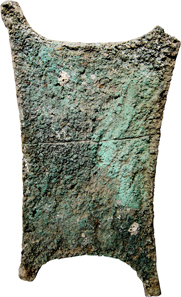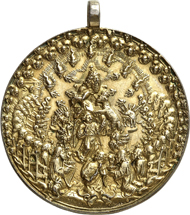12-10-2014 – 16-10-2014
Auction sales 224-226
Marvelous Rarities and Collections at Gorny & Mosch
From 13 to 17 October, 2014 there will be something spectacular at Gorny & Mosch’s agenda. Auction sale #224 offers magnificent rarities dating from ancient times, including sensations like a silver medallion of Trajan. In auction sale #225 the collector of ancient coins who is either not willing or not able to spend a fortune finds something to his liking. And apart from single highlights, there are two very special collections on offer in auction sale 226: The Jaggi Collection ‘Pledges of Divine Protection’ and the ‘Collection of a Numisnautic’.
Auction sale 224 – High-quality ancient coins
They are the icons of pre-monetary money, these copper ingots in the shape of an animal hide, made after 1600 B. C.
Lot 1: PRE-MONETARY MONEY. Ingot in the shape of an ox hide, c. 1600-1000 B. C. (72 x 39.5cm). 26.66kg. Green patina, scratches on obv., one edge is cracked. Estimate: 25,000 euros.
With one of these pieces the auction sale kicks off on 13 October, 2014. The object with its weight of 26.6kg is estimated at 25,000 euros.
And that is only the beginning. It is really hard to take one’s pick here from the rarities included in the ample offer. But how about the posthumous gold stater of the Macedonian king Philip II, whose obverse depiction is often interpreted as a portrait of Alexander (126, EF, estimate: 5,000 euros), or the double stater of Alexander the Great, minted during his lifetime at Aigai (139, EF, estimate: 15,000 euros). Another suitable candidate would be the stater of the Delphic Amphictiony, a perfect example of the issue that was used to finance the building of the new Temple of Apollo after the fire (177A, about EF, estimate: 30,000 euros). Next is a comprehensive series of more than 20 Athenian owls, including some gorgeous pieces dating from archaic times (185-188, all good VF, estimate: from 1,000 to 2,500 euros).
Lot 220A: KNOSSOS (Crete). Stater, c. 425-360 B. C. Very rare. Very fine. Estimate: 30,000 euros.
Another highlight is the archaizing stater from Knossos that depicts the Minotaur on its obverse and the maze on its reverse (220A, VF, estimate: 30,000 euros). Be it an electrum stater from Lampsakos (227, EF, estimate: 12,000 euros), a tetradrachm from Rhodes (252, EF, estimate: 15,000 euros) or an extraordinarily well preserved tetradrachm of Seleucus I (276, EF, estimate: 15,000 euros) – the admirer of Greek coins has pretty much to choose from. Naturally, this also holds true for the ones who love more exotic things. A case in point is the tetradrachm of Baydad from the 3rd cent. B. C. (309, VF, estimate: 5,500 euros).
The Roman Republic likewise is well represented by rarities and many splendidly preserved specimens. The unchallenged highlight of this section is the famous denarius of M. Iunius Brutus, celebrating the assassination of Caesar with its depiction of daggers and the liberty cap (413, good VF, estimate: 35,000 euros).
This takes us right to the coinage of Roman imperial times where there are even more rarities to be found. A small series of aurei of Tiberius (446-450, EF and Proof, estimate: 3,000 to 7,500 euros) is followed up by two aurei of Otho, the first being extremely fine with lustre (470, estimate: 50,000 euros), the other one very fine (471, estimate: 15,000 euros), as well as an aureus of Vitellius (473, VF-EF, estimate: 15,000 euros).
Lot 511: TRAJAN, 98-117. Medallion, 106-107, Rome. Obv. RIC -. C. 1var. Strack 118var. BMC 257var. MIR 259var. Mittag p. 138 Tra 6. Unique specimen. Light toning, tiny scratches on both obverse and reverse, about extremely fine. Estimate: 150,000 euros.
The gem of this auction sale is a unique medallion of Trajan depicting an adventus scene on the reverse. The marvelous piece was minted to be distributed on the occasion of the return of Trajan from the campaigns against the Dacians (511, about EF, estimate: 150,000 euros).
Only a third of that estimate is the sum that a collector is expected to pay which intends to enrich his collection by the extremely fine bronze medallion of Antoninus Pius, minted with a slightly elevated edge and graced by Apollo as Citharede.
That of course is not yet the end of the sale’s rarities. Let us only have one concluding look at an aureus of Trajanus Decius (652, Proof, estimate: 10,000 euros) and its counterpart in its ancient setting (653, EF, estimate: 8,000 euros).
Auction sale 225 – Ancient coins and multiple lots
Strictly speaking, this preview focusing on the most expensive items is not appropriate since one does not have to have lots of money to acquire some attractive pieces as an addition to one’s collection. If you find that hard to believe, please browse through auction sale catalog #225. It includes, with estimates that are not that high, artistically and historically interesting coins that were produced by cities that are difficult to locate even for the expert. A case in point is the trihemiobol from the Thessalian city of Kierion that depicts the nymph Arne on the reverse giving prophecies with astragals (1393, about EF, estimate: 500 euros).
Lot 1689: TIGRANES IV, 10/6-5 B. C. AE Chalkos, A. D. 2, Artashat Mint. Very rare. Very fine. Estimate: 500 euros.
A small series of Armenian coins no doubt will attract fans for it entails some rarities, too, like a bronze chalkos of Tigranes IV, struck in Artashat in A. D. 2 (1689, VF, estimate: 500 euros).
The admirers of Roman coins dating from the 3rd century surely will make the small series of very rare legionary antoniniani of Gallienus raise their rather modest estimates (2300-2315, VF and VF-EF, estimate: 100 to 150 euros). The same holds true for the coins of Postumus which likewise include one or another very rare and quite well preserved specimen, like an antoninianus from Trier with the portrait of the emperor to the left, in heroic nudity with both the club and the lionskin of Hercules (2365, about EF, estimate: 500 euros).
And of course there are the multiple lots that should not go unnoticed here and which virtually enjoy cult status with Gorny & Mosch. The catalog comprises 160 numbers that are highly likely to attract much interest.
Auction sale 226 – Medieval and modern times
The auction sale “Medieval and modern times” starts with a collection that is unparalleled on the market so far. Werner Jaggi used to collect everything related to the Catholic faith. He assembled a huge collection of religious art. A small part of this were numismatic testimonies of religious customs as it found expression in pendants, crosses, coined amulets and medals. These objects are intriguing not only to the one interested in art history. The local collector, too, discovers items he never knew before. They bear witness to a time when reason was not the universal standard. The stories they tell sound unbelievable to the modern ear, e.g. the one of the rich peasant who only fulfilled his vow when his hen had laid an egg on whose shell he believed to see Virgin Mary with an aureole. The cloister of Maria Stern, which derived its name from this story, attracted people from far and wide. The egg still is part of the coat of arms of the Bavarian city of Odelzhausen where the cloister of Odelzhausen used to be located. Two lots of the collection are devoted to this legend (3189 and 3190, both VF, 150 resp. 100 euros).
Lot 3369: JAGGI COLLECTION. Gilded and mounted presentation medallion 1539, signed HR (Hans Reinhard the Elder). Extremely rare. Antique gold plated, extremely fine original cast. Estimate: 2,500 euros.
Apart from that, Werner Jaggi collected religious and papal medals, so that the connoisseur can choose from an ample range of offers, including examples from the Renaissance, like a rare medallion of Hans Reinhardt the Elder that depicts the Apokalyptic Christ on the obverse and God the Father with the lamb surrounded by the 24 Elders on the reverse (3369, extremely fine original cast, estimate: 2,500 euros).
Part II of the auction sale offers the Collection of a Numisnautic, hence coins and medals depicting nautical subjects such as ships, lighthouses, harbors etc. The items available for sale cover a Greek galley (3692, medal on the 70th birthday of State Chancellor Hardenberg 1820, EF-Proof, estimate: 300 euros), a cargo ship on a rhinegoldducat (3686, Bavaria 1846, EF/Proof, estimate: 2,000 euros) as well as a paddleboat of the Industrial Revolution (3777, bronze medal 1843, EF-Mint State, estimate: 150 euros).
The collector was not afraid to buy expensive coins for his collection, too.
Lot 3736: COLLECTION OF A NUMISNAUTIC. Mainz, Archbishopric. Friedrich Karl Josef von Erthal, 1774-1802. Konventionsthaler 1795, Mainz. Ex Peus 404-405 (2011), lot 796. Extremely rare. Proof. Estimate: 15,000 euros.
This is why it includes great rarities like a schiffsthaler of William VI of Hesse-Kassel from 1655 (3730, EF-Proof, estimate: 8,000 euros), an extremely rare Mainz konventionsthaler from 1795 (3736, Proof, estimate: 15,000 euros) or a large medal by Sebastian Dadler from 1644 on the Danish naval victory at Fehmarn and the declaration of maturity of Christina, Queen of Sweden (3832, VF, estimate: 5,000 euros). These are just a few examples. Every special collector can find something to his liking because the estimates start as low as the mean two-digit range and can be as high as something in the five-digit range.
We have arrived at the third, general, part of the sale as yet another field where the expert discovers a great number of rarities, of which we can only present a selected few here. From Germany comes a ducat of Frederick, King in Prussia, from 1701 (4258, EF, estimate: 15,000 euros), a 1/4 portugalöser of 2 1/2 ducats from Hamburg with no date (4282, EF, estimate: 20,000 euros) and a thaler no date of Georg Christian, Regent of East Frisia, 1660-1665 (4307, about EF, estimate: 15,000 euros).
There is one distinct element which is omnipresent in this catalog and this is medals. The connoisseur is faced with a broad spectrum including a small series of modern art medals designed by the Finnish artist Kauko Räsänen. Admirers of phaleristics will get the opportunity to acquire orders. A highlight to the aficionado is without a doubt the Bavarian Military Merit Order 2nd Class with Crown and Swords, in addition the breast star of the order plus the awarding documents.
Lot 4723: ITALY. Sicily. Frederick II, 1197/1220-1250. Augustalis n. y. (after 1231), Messina. Very rare. Extremely fine. Estimate: 10,000 euros.
Let us conclude this preview with some rare pieces from abroad, like an augustalis of Frederick II of Sicily (4723, EF, estimate: 10,000 euros), a 100 perpera piece from Montenegro, minted in Vienna in 1910 (4779, EF-Proof, estimate: 15,000 euros) and an extremely rare set comprising three Hungarian gold coins, minted in 1966 on the 400th anniversary of the death of the military leader Zrinyi (4866, PP, estimate: 12,000 euros).
All catalogs can be viewed on the internet here.
Here you may find the catalog of the auction sale 224.
And on this site the catalog of the auction sale 225.
And here you may see all offerings of the auction sale 226.
Printed catalogs can be ordered at Gorny & Mosch, Giessener Münzhandlung, Maximiliansplatz 20, D-80333 Munich, phone +49 / (0)89 / 24 22 643-0, telefax +49 / (0)89 / 22 85 513.

















